Chemically Crosslinked Bispecific Antibodies for Cancer Therapy: Breaking from the Structural Restrictions of the Genetic Fusion Approach
Abstract
1. Introduction
2. Results
2.1. Mutation of Lysine Residues in h528 Fv
2.2. Mutation of Lysine Residues in hOKT3 Fv
2.3. Chemical Conjugation for Forming Homo scFv Dimers
2.4. Binding of Bivalent scFv Dimers to Target-Immobilized Substrate
2.5. Binding of Bivalent scFv Dimers to Target-Displaying Cells
2.6. scFv Dimers Bispecific Towards Cancer and T-Cells
3. Discussion
4. Materials and Methods
4.1. Expression and Purification of Recombinant Antibodies
4.2. Chemical Conjugation for Constructing scFv Dimers
4.3. SPR Analysis
4.4. Preparation of T-LAK and Cancer Cells
4.5. Flow Cytometric Analysis
4.6. In Vitro Cytotoxicity Assay
Supplementary Materials
Author Contributions
Funding
Acknowledgments
Conflicts of Interest
References
- Holliger, P.; Hudson, P.J. Engineered antibody fragments and the rise of single domains. Nat. Biotechnol. 2005, 23, 1126–1136. [Google Scholar] [CrossRef]
- Sandborn, W.J.; Feagan, B.G.; Stoinov, S.; Honiball, P.J.; Rutgeerts, P.; Mason, D.; Bloomfield, R.; Schreiber, S. Certolizumab pegol for the treatment of Crohn’s disease. N. Engl. J. Med. 2007, 357, 228–238. [Google Scholar] [CrossRef] [PubMed]
- Nesbitt, A.; Fossati, G.; Bergin, M.; Stephens, P.; Stephens, S.; Foulkes, R.; Brown, D.; Robinson, M.; Bourne, T. Mechanism of action of certolizumab pegol (CDP870): In vitro comparison with other anti-tumor necrosis factor α agents. Inflamm. Bowel Dis. 2007, 13, 1323–1332. [Google Scholar] [CrossRef] [PubMed]
- Lu, R.M.; Chang, Y.L.; Chen, M.S.; Wu, H.C. Single chain anti-c-Met antibody conjugated nanoparticles for in vivo tumor-targeted imaging and drug delivery. Biomaterials 2011, 32, 3265–3274. [Google Scholar] [CrossRef] [PubMed]
- Cheng, S.; Hotani, K.; Hideshima, S.; Kuroiwa, S.; Nakanishi, T.; Hashimoto, M.; Mori, Y.; Osaka, T. Field effect transistor biosensor using antigen binding fragment for detecting tumor marker in human serum. Materials 2014, 7, 2490–2500. [Google Scholar] [CrossRef] [PubMed]
- Osaki, T.; Fujisawa, S.; Kitaguchi, M.; Kitamura, M.; Nakanishi, T. Development of a bispecific antibody tetramerized through hetero-associating peptides. FEBS J. 2015, 282, 4389–4401. [Google Scholar] [CrossRef] [PubMed]
- Borsi, L.; Balza, E.; Carnemolla, B.; Sassi, F.; Castellani, P.; Berndt, A.; Kosmehl, H.; Birò, A.; Siri, A.; Orecchia, P.; et al. Selective targeted delivery of TNFα to tumor blood vessels. Blood 2003, 102, 4384–4392. [Google Scholar] [CrossRef]
- Valedkarimi, Z.; Nasiri, H.; Aghebati-Maleki, L.; Majidi, J. Antibody-cytokine fusion proteins for improving efficacy and safety of cancer therapy. Biomed. Pharm. 2017, 95, 731–742. [Google Scholar] [CrossRef]
- Zhang, S.; Lai, X.; Yang, G. Enzyme-linked Fab fragment based competitive immunoassay for ovalbumin in hot-processed food. J. Immunoass. Immunochem. 2013, 34, 393–403. [Google Scholar] [CrossRef]
- Kornberger, P.; Skerra, A. Sortase-catalyzed in vitro functionalization of a HER2-specific recombinant Fab for tumor targeting of the plant cytotoxin gelonin. MAbs 2014, 6, 354–366. [Google Scholar] [CrossRef]
- Jackman, J.; Chen, Y.; Huang, A.; Moffat, B.; Scheer, J.M.; Leong, S.R.; Lee, W.P.; Zhang, J.; Sharma, N.; Lu, Y.; et al. Development of a two-part strategy to identify a therapeutic human bispecific antibody that inhibits IgE receptor signaling. J. Biol. Chem. 2010, 285, 20850–20859. [Google Scholar] [CrossRef] [PubMed]
- Chames, P.; Baty, D. Bispecific antibodies for cancer therapy: The light at the end of the tunnel? MAbs 2009, 1, 539–547. [Google Scholar] [CrossRef] [PubMed]
- Hoffmann, P.; Hofmeister, R.; Brischwein, K.; Brandl, C.; Crommer, S.; Bargou, R.; Itin, C.; Prang, N.; Baeuerle, P.A. Serial killing of tumor cells by cytotoxic T cells redirected with a CD19-/CD3-bispecific single-chain antibody construct. Int. J. Cancer 2005, 115, 98–104. [Google Scholar] [CrossRef] [PubMed]
- Baeuerle, P.A.; Reinhardt, C. Bispecific T-cell engaging antibodies for cancer therapy. Cancer Res. 2009, 69, 4941–4944. [Google Scholar] [CrossRef]
- Raso, V.; Griffin, T. Hybrid antibodies with dual specificity for the delivery of ricin to immunoglobulin-bearing target cells. Cancer Res. 1981, 41, 2073–2078. [Google Scholar]
- Suresh, M.R.; Cuello, A.C.; Milstein, C. Bispecific monoclonal antibodies from hybrid hybridomas. Methods Enzym. 1986, 121, 210–228. [Google Scholar]
- Kriangkum, J.; Xu, B.; Nagata, L.P.; Fulton, R.E.; Suresh, M.R. Bispecific and bifunctional single chain recombinant antibodies. Biomol. Eng. 2001, 18, 31–40. [Google Scholar] [CrossRef]
- Labrijn, A.F.; Janmaat, M.L.; Reichert, J.M.; Parren, P.W.H.I. Bispecific antibodies: A mechanistic review of the pipeline. Nat. Rev. Drug Discov. 2019, 18, 585–608. [Google Scholar] [CrossRef]
- Asano, R.; Sone, Y.; Makabe, K.; Tsumoto, K.; Hayashi, H.; Katayose, Y.; Unno, M.; Kudo, T.; Kumagai, I. Humanization of the bispecific epidermal growth factor receptor x CD3 diabody and its efficacy as a potential clinical reagent. Clin. Cancer Res. 2006, 12, 4036–4042. [Google Scholar] [CrossRef]
- Takemura, S.; Asano, R.; Tsumoto, K.; Ebara, S.; Sakurai, N.; Katayose, Y.; Kodama, H.; Yoshida, H.; Suzuki, M.; Imai, K.; et al. Construction of a diabody (small recombinant bispecific antibody) using a refolding system. Protein Eng. 2000, 13, 583–588. [Google Scholar] [CrossRef][Green Version]
- Fujii, H.; Tanaka, Y.; Nakazawa, H.; Sugiyama, A.; Manabe, N.; Shinoda, A.; Shimizu, N.; Hattori, T.; Hosokawa, K.; Sujino, T.; et al. Compact seahorse-shaped T cell-activating antibody for cancer therapy. Adv. Ther. 2018, 1, 1700031. [Google Scholar] [CrossRef]
- Acchione, M.; Kwon, H.; Jochheim, C.M.; Atkins, W.M. Impact of linker and conjugation chemistry on antigen binding, Fc receptor binding and thermal stability of model antibody-drug conjugates. MAbs 2012, 4, 362–372. [Google Scholar] [CrossRef] [PubMed]
- Glazer, A.N. Specific chemical modification of proteins. Annu. Rev. Biochem. 1970, 39, 101–130. [Google Scholar] [CrossRef] [PubMed]
- Means, G.E.; Feeney, R.E. Chemical modifications of proteins: History and applications. Bioconjug. Chem. 1990, 1, 2–12. [Google Scholar] [CrossRef] [PubMed]
- Goto, Y.; Hamaguchi, K. The role of the intrachain disulfide bond in the conformation and stability of the constant fragment of the immunoglobulin light chain. J. Biochem. 1979, 86, 1433–1441. [Google Scholar] [CrossRef] [PubMed]
- Glockshuber, R.; Schmidt, T.; Plückthun, A. The disulfide bonds in antibody variable domains: Effects on stability, folding in vitro, and functional expression in Escherichia coli. Biochemistry 1992, 31, 1270–1279. [Google Scholar] [CrossRef]
- Lillo, A.M.; Sun, C.; Gao, C.; Ditzel, H.; Parrish, J.; Gauss, C.M.; Moss, J.; Felding-Habermann, B.; Wirsching, P.; Boger, D.L.; et al. A human single-chain antibody specific for integrin α 3β1 capable of cell internalization and delivery of antitumor agents. Chem. Biol. 2004, 11, 897–906. [Google Scholar] [CrossRef][Green Version]
- Makabe, K.; Nakanishi, T.; Tsumoto, K.; Tanaka, Y.; Kondo, H.; Umetsu, M.; Sone, Y.; Asano, R.; Kumagai, I. Thermodynamic consequences of mutations in vernier zone residues of a humanized anti-human epidermal growth factor receptor murine antibody, 528. J. Biol. Chem. 2008, 283, 1156–1166. [Google Scholar] [CrossRef]
- Adair, J.R.; Athwal, D.S.; Bodmer, M.W.; Bright, S.M.; Collins, A.M.; Pulito, V.L.; Rao, P.E.; Reedman, R.; Rothermel, A.L.; Xu, D.; et al. Humanization of the murine anti-human CD3 monoclonal antibody OKT3. Hum. Antibodies Hybrid. 1994, 1, 41–47. [Google Scholar] [CrossRef]
- Nakanishi, T.; Maru, T.; Tahara, K.; Sanada, H.; Umetsu, M.; Asano, R.; Kumagai, I. Development of an affinity-matured humanized anti-epidermal growth factor receptor antibody for cancer immunotherapy. Protein Eng. Des. Sel. 2013, 26, 113–122. [Google Scholar] [CrossRef]
- Sanada, H.; Kobayashi, K.; Oyama, K.; Maru, T.; Nakanishi, T.; Umetsu, M.; Asano, R.; Kumagai, I. Affinity maturation of humanized anti-epidermal growth factor receptor antibody using a modified phage-based open sandwich selection method. Sci. Rep. 2018, 8, 5414. [Google Scholar] [CrossRef] [PubMed]
- Onda, M.; Vincent, J.J.; Lee, B.; Pastan, I. Mutants of Immunotoxin Anti-Tac(dsFv)-PE38 with Variable Number of Lysine Residues as Candidates for Site-Specific Chemical Modification. 1. Properties of Mutant Molecules. Bioconjug. Chem. 2003, 14, 480–487. [Google Scholar] [CrossRef] [PubMed]
- Johnson, G. Kabat Database and its applications: 30 years after the first variability plot. Nucleic Acids Res. 2000, 28, 214–218. [Google Scholar] [CrossRef] [PubMed]
- Kjer-Nielsen, L.; Dunstone, M.A.; Kostenko, L.; Ely, L.K.; Beddoe, T.; Mifsud, N.A.; Purcell, A.W.; Brooks, A.G.; McCluskey, J.; Rossjohn, J. Crystal structure of the human T cell receptor CD3εγ heterodimer complexed to the therapeutic mAb OKT3. Proc. Natl. Acad. Sci. USA 2004, 101, 7675–7680. [Google Scholar] [CrossRef]
- Asano, R.; Ikoma, K.; Shimomura, I.; Taki, S.; Nakanishi, T.; Umetsu, M.; Kumagai, I. Cytotoxic enhancement of a bispecific diabody by format conversion to tandem single-chain variable fragment (taFv): The case of the hEx3 diabody. J. Biol. Chem. 2011, 286, 1812–1818. [Google Scholar] [CrossRef]
- Tian, F.; Lu, Y.; Manibusan, A.; Sellers, A.; Tran, H.; Sun, Y.; Phuong, T.; Barnett, R.; Hehli, B.; Song, F.; et al. A general approach to site-specific antibody drug conjugates. Proc. Natl. Acad. Sci. USA 2014, 111, 1766–1771. [Google Scholar] [CrossRef]
- Sereda, T.J.; Mant, C.T.; Quinn, A.M.; Hodges, R.S. Effect of the α-amino group on peptide retention behaviour in reversed-phase chromatography Determination of the pKa values of the α-amino group of 19 different N-terminal amino acid residues. J. Chromatogr. A 1993, 646, 17–30. [Google Scholar] [CrossRef]
- Chen, D.; Disotuar, M.M.; Xiong, X.; Wang, Y.; Chou, D.H.C. Selective N-terminal functionalization of native peptides and proteins. Chem. Sci. 2017, 8, 2717–2722. [Google Scholar] [CrossRef]
- Chan, A.O.Y.; Ho, C.M.; Chong, H.C.; Leung, Y.C.; Huang, J.S.; Wong, M.K.; Che, C.M. Modification of N-terminal α-amino groups of peptides and proteins using ketenes. J. Am. Chem. Soc. 2012, 134, 2589–2598. [Google Scholar] [CrossRef]
- Asano, R.; Kumagai, T.; Nagai, K.; Taki, S.; Shimomura, I.; Arai, K.; Ogata, H.; Okada, M.; Hayasaka, F.; Sanada, H.; et al. Domain order of a bispecific diabody dramatically enhances its antitumor activity beyond structural format conversion: The case of the hEx3 diabody. Protein Eng. Des. Sel. 2013, 26, 359–367. [Google Scholar] [CrossRef]
- Sugiyama, A.; Umetsu, M.; Nakazawa, H.; Niide, T.; Onodera, T.; Hosokawa, K.; Hattori, S.; Asano, R.; Kumagai, I. A semi high-throughput method for screening small bispecific antibodies with high cytotoxicity. Sci. Rep. 2017, 7, 2862. [Google Scholar] [CrossRef] [PubMed]
- Perisic, O.; Webb, P.A.; Holliger, P.; Winter, G.; Williams, R.L. Crystal structure of a diabody, a bivalent antibody fragment. Structure 1994, 2, 1217–1226. [Google Scholar] [CrossRef]
- Carmichael, J.A.; Power, B.E.; Garrett, T.P.J.; Yazaki, P.J.; Shively, J.E.; Raubischek, A.A.; Wu, A.M.; Hudson, P.J. The crystal structure of an anti-CEA scFv diabody assembled from T84.66 scFvs in VL-to-VH orientation: Implications for diabody flexibility. J. Mol. Biol. 2003, 326, 341–351. [Google Scholar] [CrossRef]
- Asano, R.; Hagiwara, Y.; Koyama, N.; Masakari, Y.; Orimo, R.; Arai, K.; Ogata, H.; Furumoto, S.; Umetsu, M.; Kumagai, I. Multimerization of anti-(epidermal growth factor receptor) IgG fragments induces an antitumor effect: The case for humanized 528 scFv multimers. FEBS J. 2013, 280, 4816–4826. [Google Scholar] [CrossRef] [PubMed]
- Umetsu, M.; Tsumoto, K.; Hara, M.; Ashish, K.; Goda, S.; Adschiri, T.; Kumagai, I. How additives influence the refolding of immunoglobulin-folded proteins in a stepwise dialysis system: Spectroscopic evidence for highly efficient refolding of a single-chain Fv fragment. J. Biol. Chem. 2003, 278, 8979–8987. [Google Scholar] [CrossRef] [PubMed]
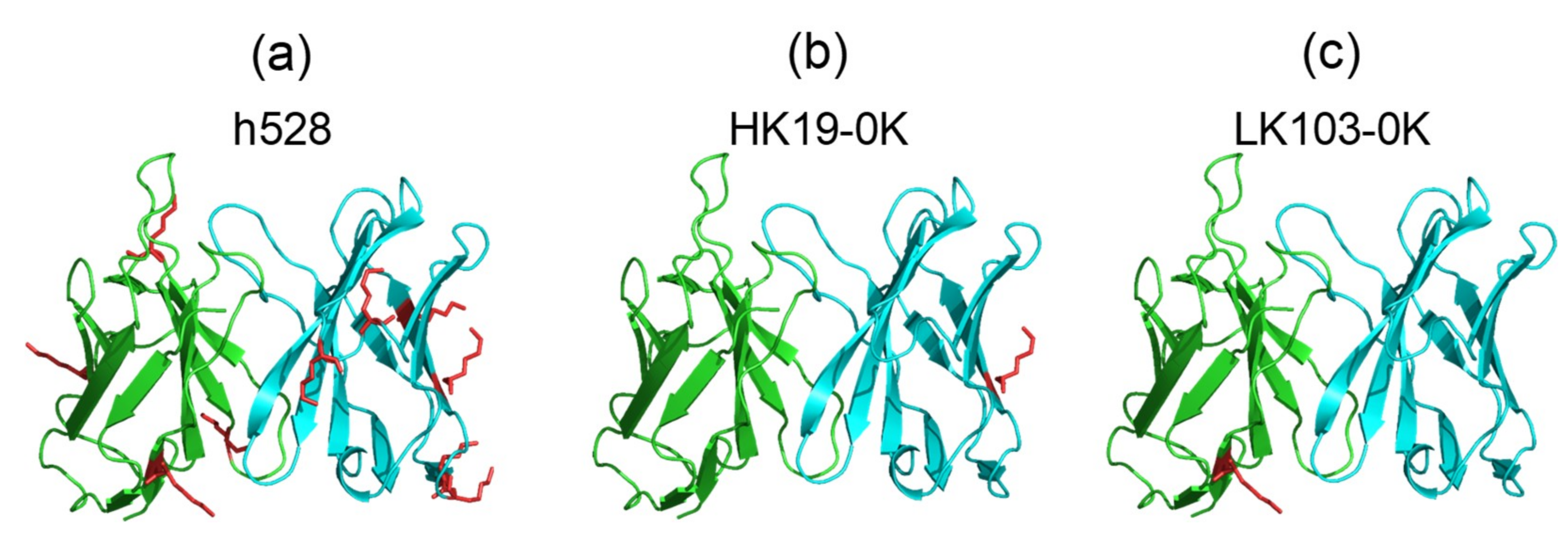
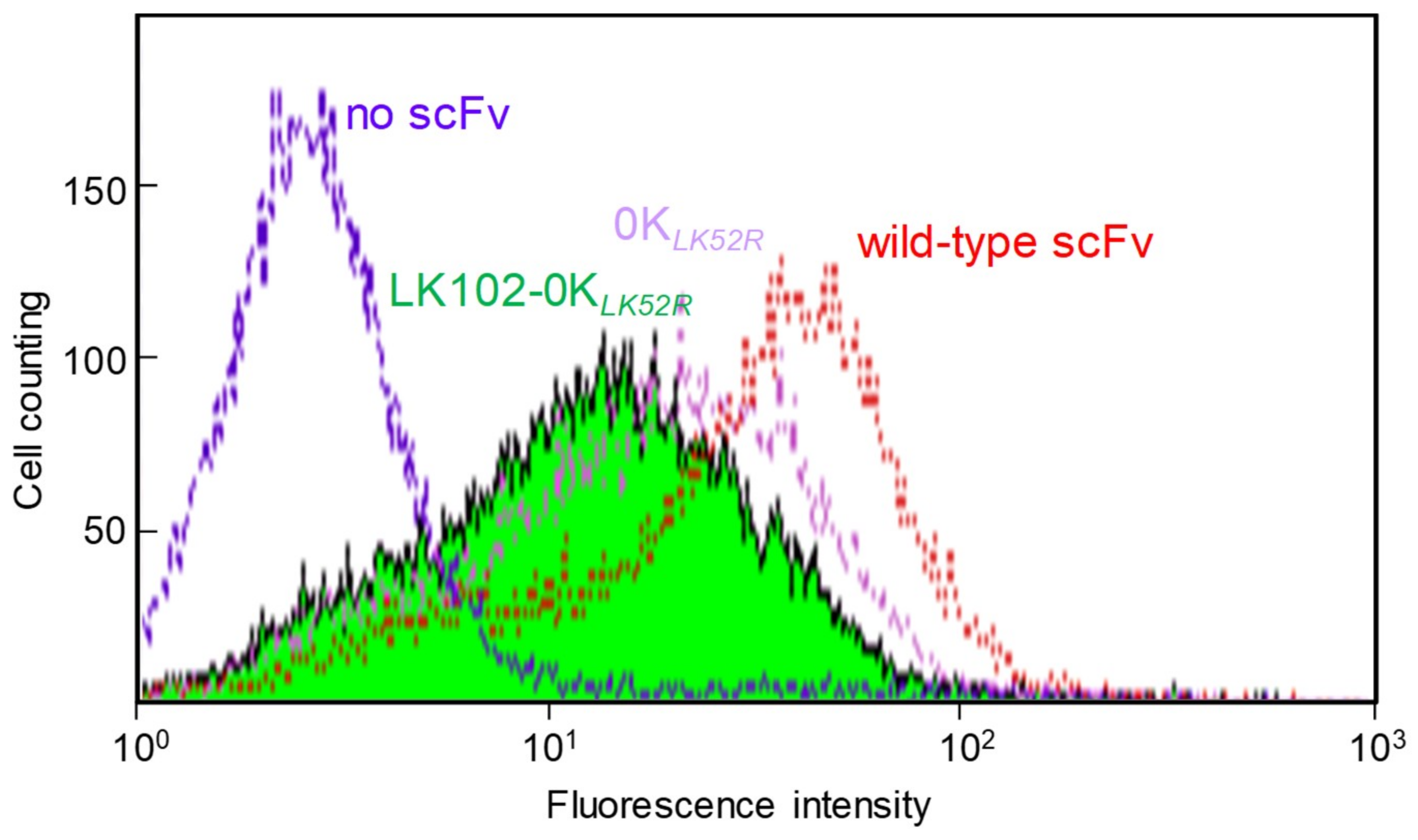
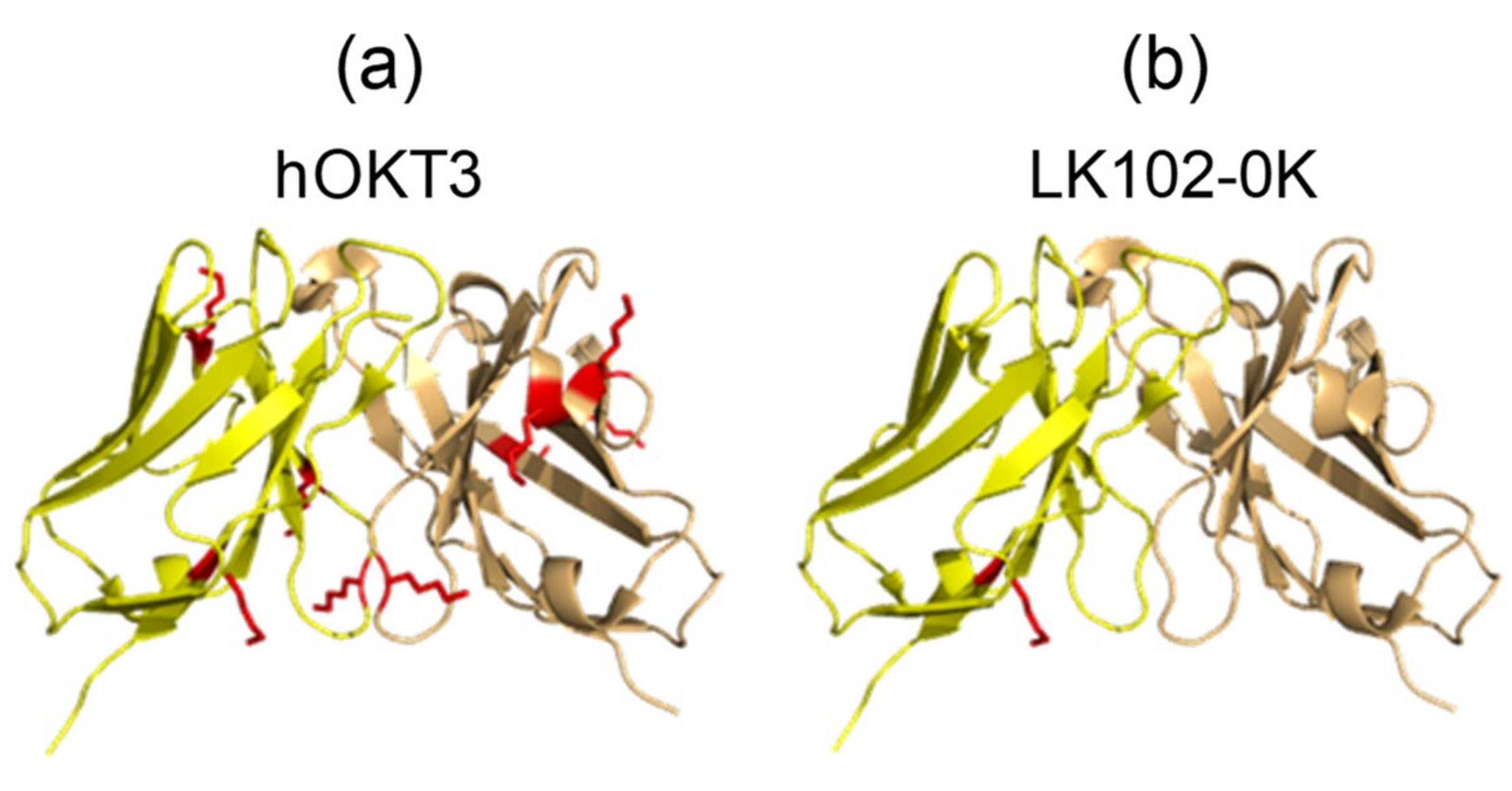
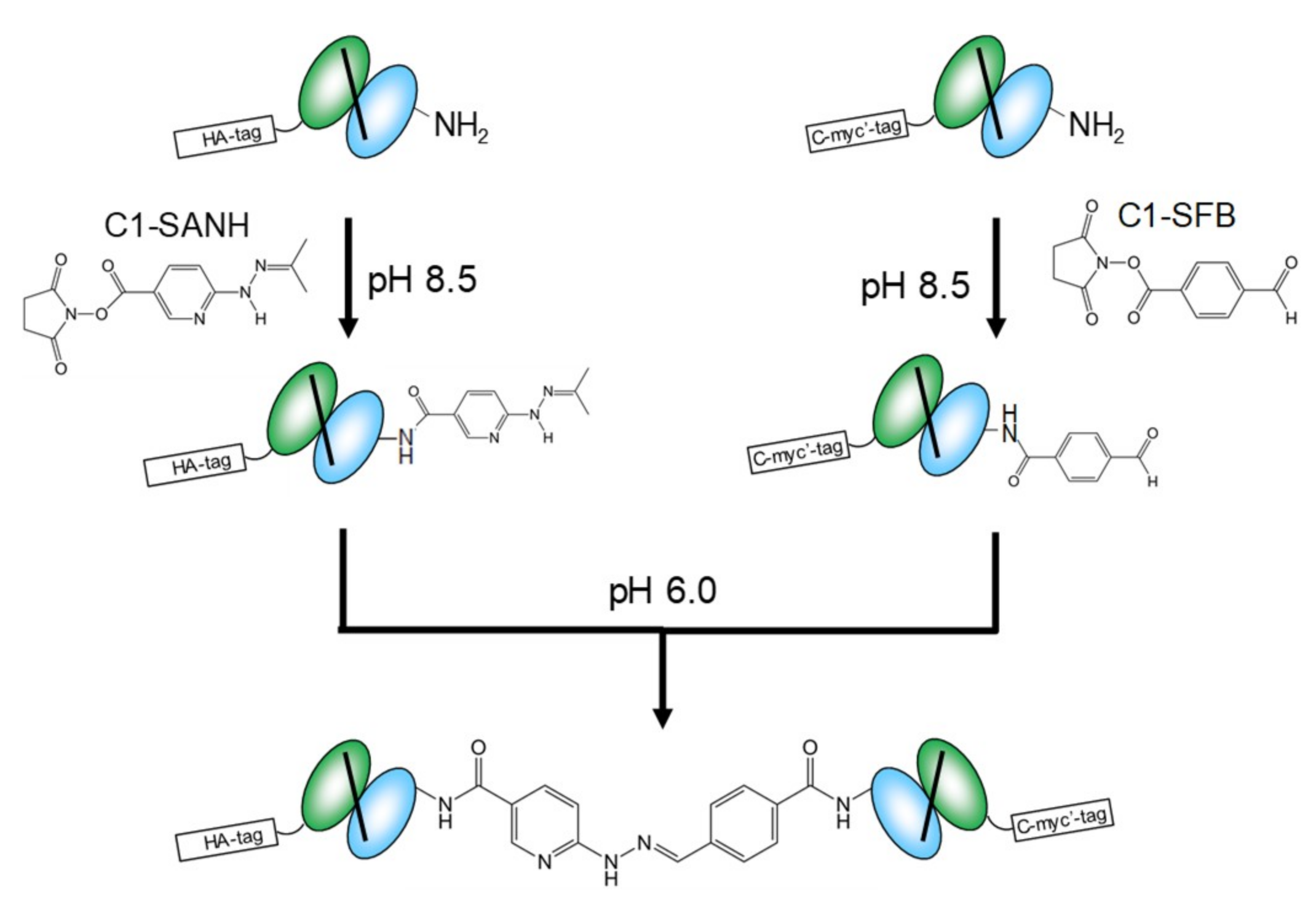
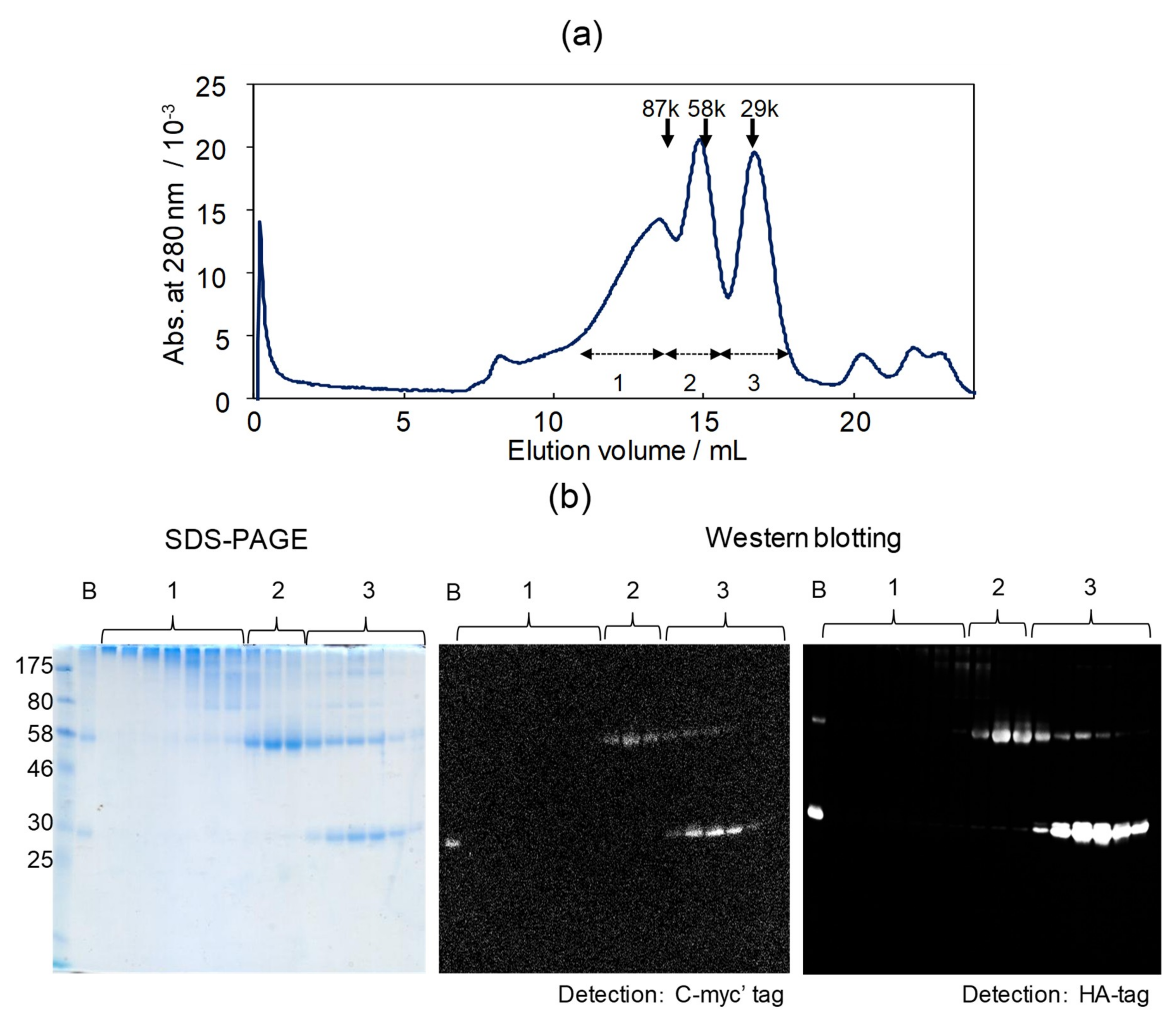

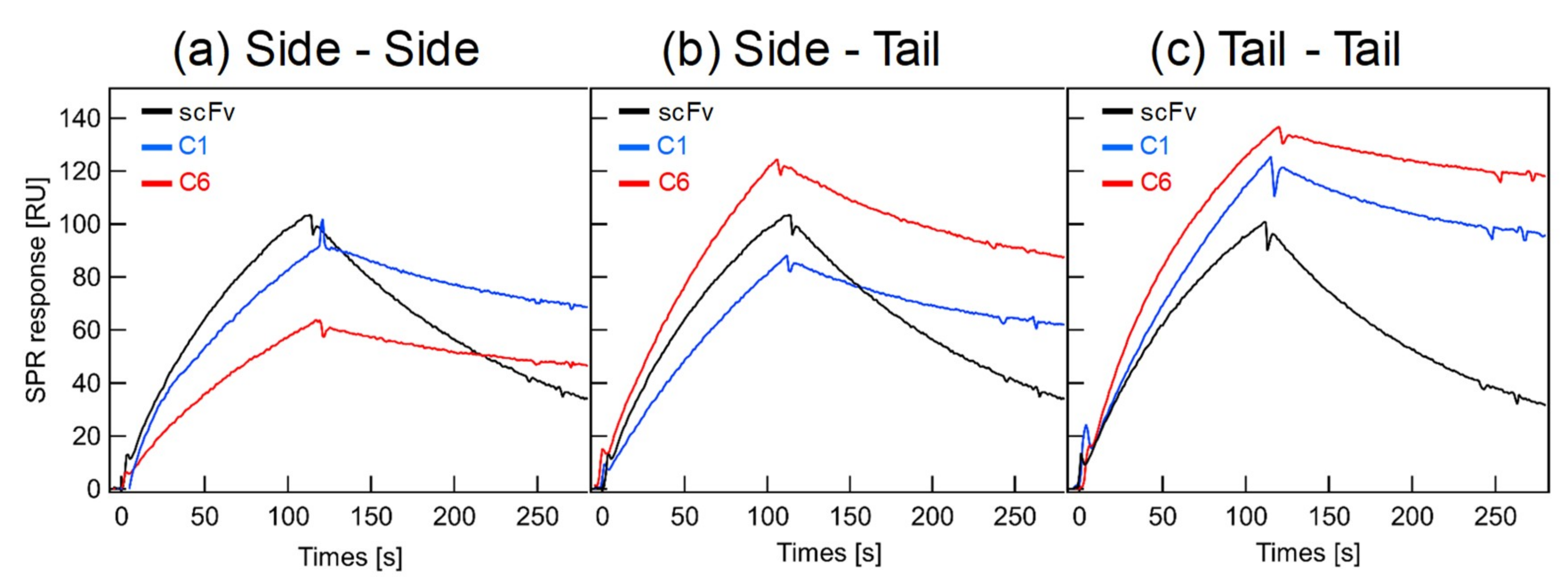
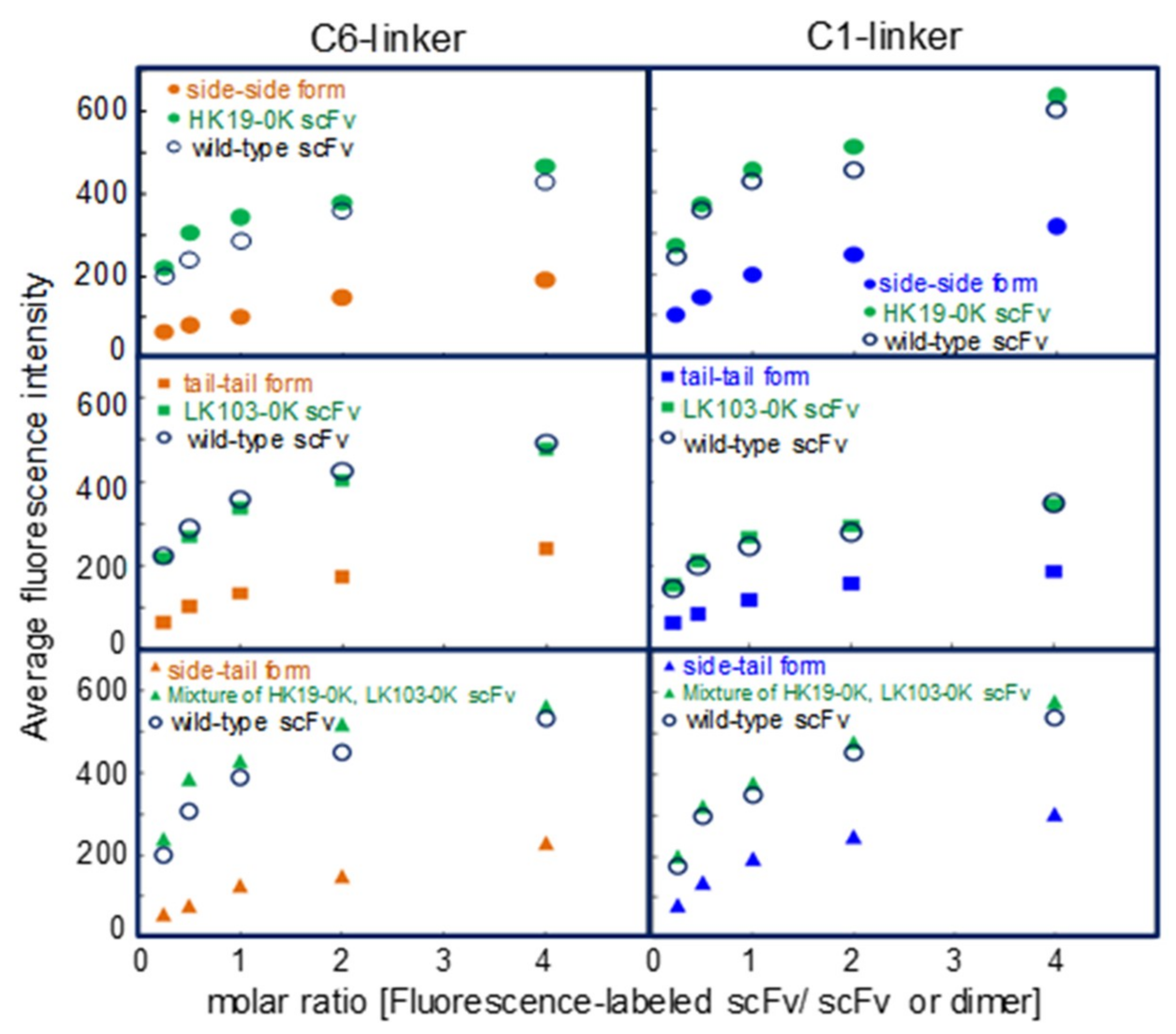
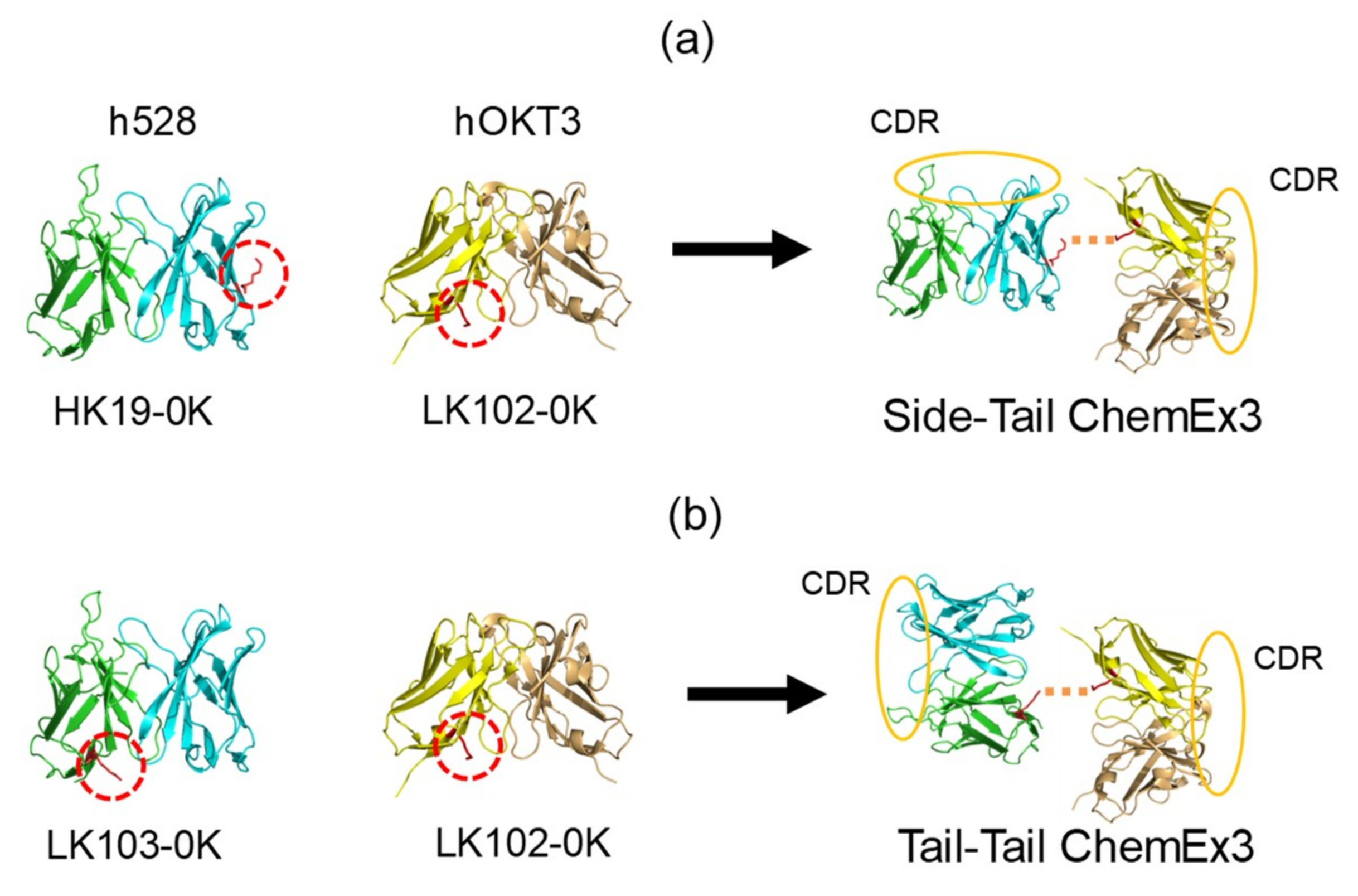
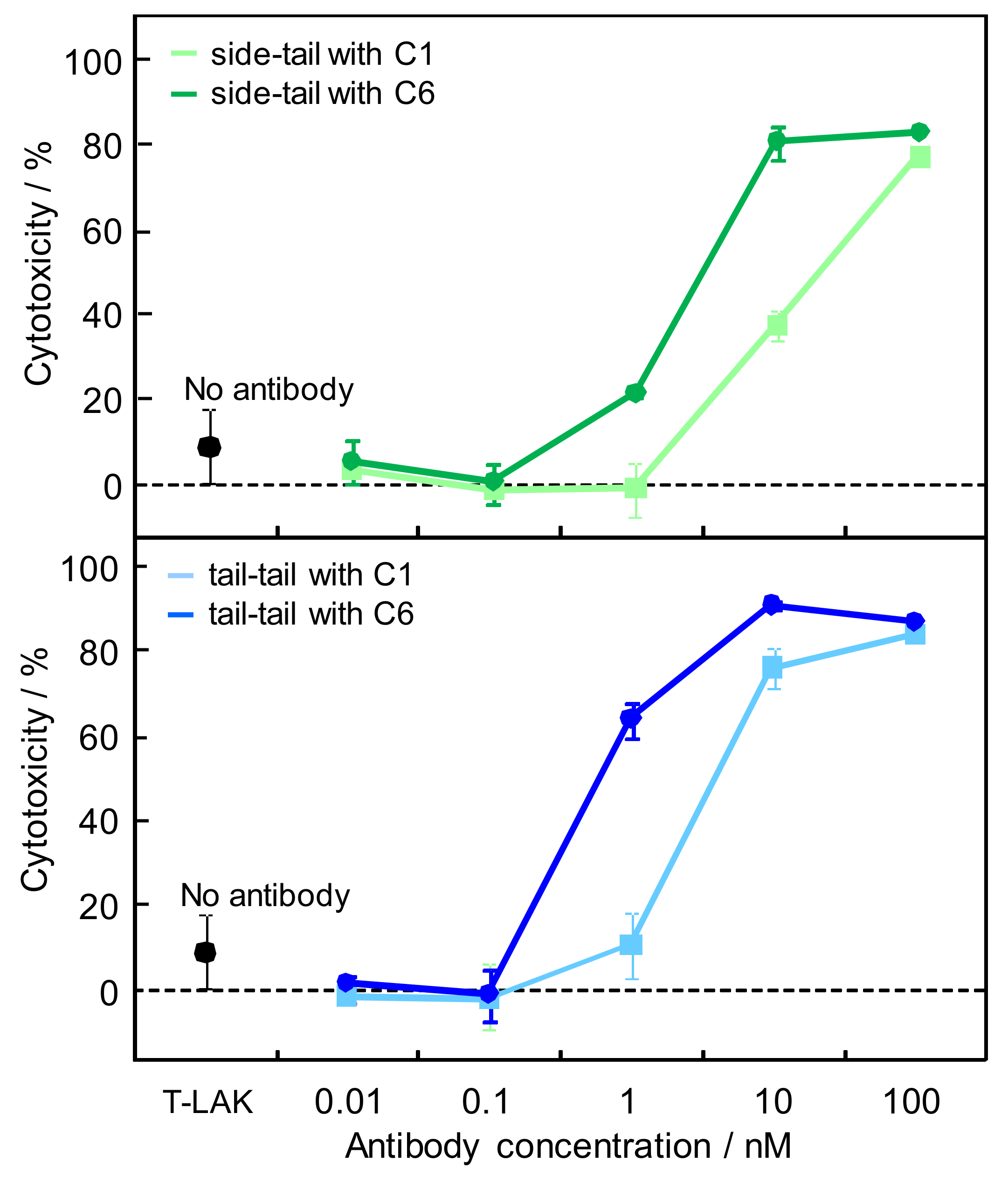
| scFv | VH | VL | |||||||||
|---|---|---|---|---|---|---|---|---|---|---|---|
| K position | K position | ||||||||||
| H12 | H13 | H19 | H23 | H62 a) | H64 a) | L39 | L50a) | L74 | L103 | L107 | |
| h528 scFv | K | K | K | K | K | K | K | K | K | K | K |
| 0KCDR | K | K | K | K | E | Q | K | Q | K | K | K |
| 0K | A | E | Q | A | E | Q | R | Q | T | E | E |
| scFv | kon (104 (Ms)−1) | koff (10−3s−1) | KD (nM) |
|---|---|---|---|
| Wild-type | 19.6 | 5.2 | 26 |
| 0KCDR | 14.1 | 5.4 | 38 |
| 0K | 6.0 | 8.2 | 137 |
| HK19-0K | 6.0 | 7.9 | 135 |
| LK103-0K | 4.2 | 8.6 | 205 |
| scFv | VH | VL | |||||||
|---|---|---|---|---|---|---|---|---|---|
| K position | K position | ||||||||
| H23 | H43 | H63 a) | H65 a) | H76 | L41 | L44 | L52 a) | L102 | |
| hOKT3 scFv | K | K | K | K | K | K | K | K | K |
| 0K | A | Q | S | Q | S | Q | Q | N | E |
| LK52-0K | A | Q | S | Q | S | Q | Q | K | E |
| 0KLK52R | A | Q | S | Q | S | Q | Q | R | E |
| LK102-0KLK52R | A | Q | S | Q | S | Q | Q | R | K |
| scFv | Immobilized EGFR (RU) | kon (104(Ms) −1) | koff (10−3s−1) | KD (nM) |
|---|---|---|---|---|
| Monomer | ||||
| HK19-0K | 1089 | 5.2 | 7.5 | 144 |
| 2789 | 6.9 | 7.5 | 108 | |
| LK103-0K | 1073 | 3.9 | 8.6 | 221 |
| 2789 | 4.3 | 8.9 | 207 | |
| Dimer | ||||
| Side–Side C1 | 1089 | 4.6 | 3.6 | 78 |
| 2833 | 6.4 | 1.9 | 31 | |
| Side–Side C6 | 1089 | 3.8 | 3.3 | 89 |
| 2833 | 5.5 | 1.9 | 34 | |
| Side–Tail C1 | 1119 | 3.4 | 5.0 | 149 |
| 2789 | 4.3 | 4.7 | 109 | |
| Side–Tail C6 | 1100 | 3.2 | 5.1 | 159 |
| 2747 | 7.2 | 4.3 | 56 | |
| Tail–Tail C1 | 1122 | 2.8 | 2.5 | 88 |
| 2605 | 3.1 | 2.0 | 64 | |
| Tail–Tail C6 | 1073 | 6.2 | 1.2 | 18 |
| 2605 | 6.3 | 1.5 | 23 | |
| scFv dimer | kon (104(Ms)−1) | koff (10−3s−1) | KD (nM) |
|---|---|---|---|
| Side–tail form | |||
| C1 | 1.9 | 5.8 | 307 |
| C6 | 3.8 | 5.8 | 160 |
| Tail–tail form | |||
| C1 | 1.5 | 5.7 | 380 |
| C6 | 3.6 | 5.7 | 160 |
© 2020 by the authors. Licensee MDPI, Basel, Switzerland. This article is an open access article distributed under the terms and conditions of the Creative Commons Attribution (CC BY) license (http://creativecommons.org/licenses/by/4.0/).
Share and Cite
Ueda, A.; Umetsu, M.; Nakanishi, T.; Hashikami, K.; Nakazawa, H.; Hattori, S.; Asano, R.; Kumagai, I. Chemically Crosslinked Bispecific Antibodies for Cancer Therapy: Breaking from the Structural Restrictions of the Genetic Fusion Approach. Int. J. Mol. Sci. 2020, 21, 711. https://doi.org/10.3390/ijms21030711
Ueda A, Umetsu M, Nakanishi T, Hashikami K, Nakazawa H, Hattori S, Asano R, Kumagai I. Chemically Crosslinked Bispecific Antibodies for Cancer Therapy: Breaking from the Structural Restrictions of the Genetic Fusion Approach. International Journal of Molecular Sciences. 2020; 21(3):711. https://doi.org/10.3390/ijms21030711
Chicago/Turabian StyleUeda, Asami, Mitsuo Umetsu, Takeshi Nakanishi, Kentaro Hashikami, Hikaru Nakazawa, Shuhei Hattori, Ryutaro Asano, and Izumi Kumagai. 2020. "Chemically Crosslinked Bispecific Antibodies for Cancer Therapy: Breaking from the Structural Restrictions of the Genetic Fusion Approach" International Journal of Molecular Sciences 21, no. 3: 711. https://doi.org/10.3390/ijms21030711
APA StyleUeda, A., Umetsu, M., Nakanishi, T., Hashikami, K., Nakazawa, H., Hattori, S., Asano, R., & Kumagai, I. (2020). Chemically Crosslinked Bispecific Antibodies for Cancer Therapy: Breaking from the Structural Restrictions of the Genetic Fusion Approach. International Journal of Molecular Sciences, 21(3), 711. https://doi.org/10.3390/ijms21030711






